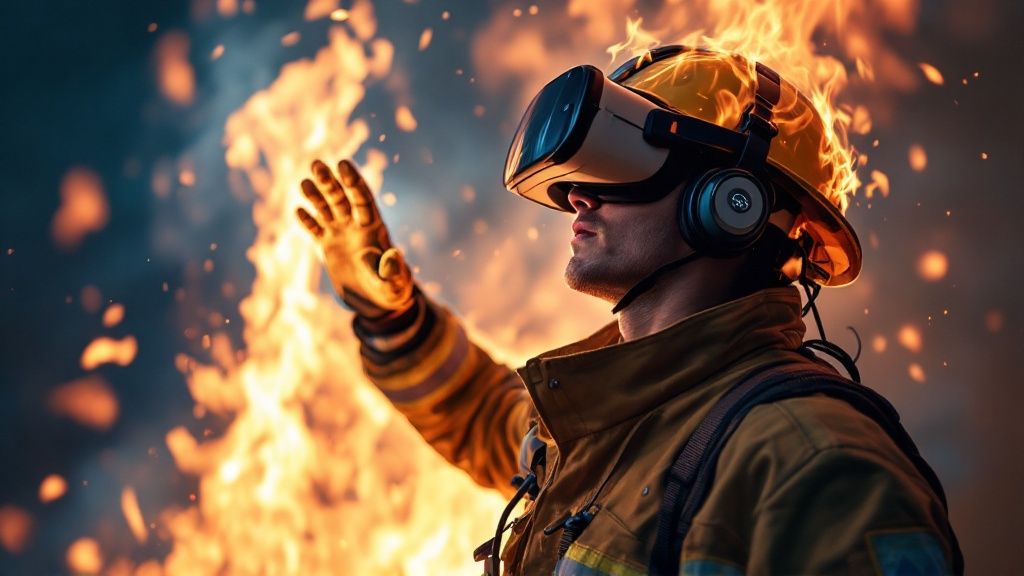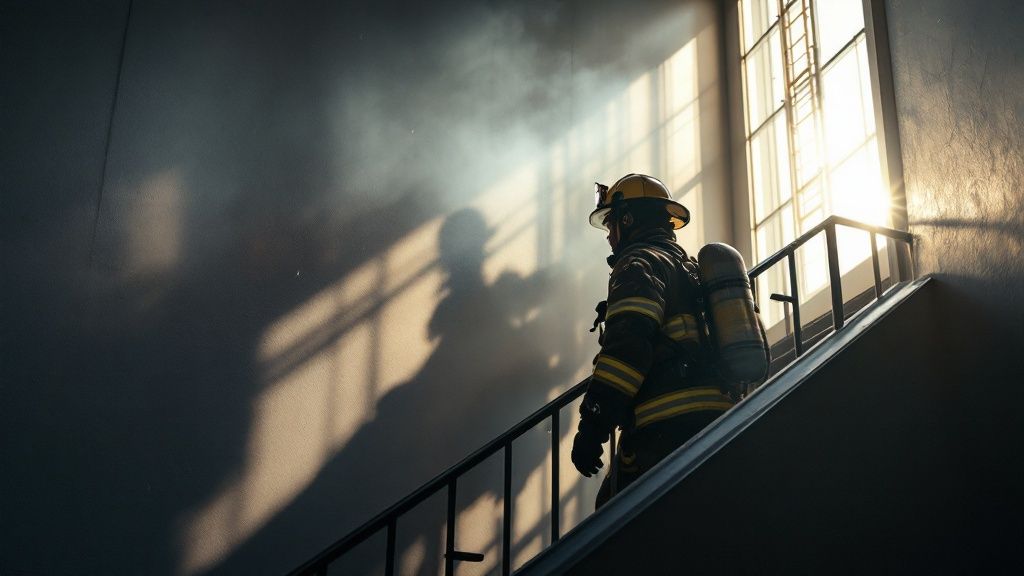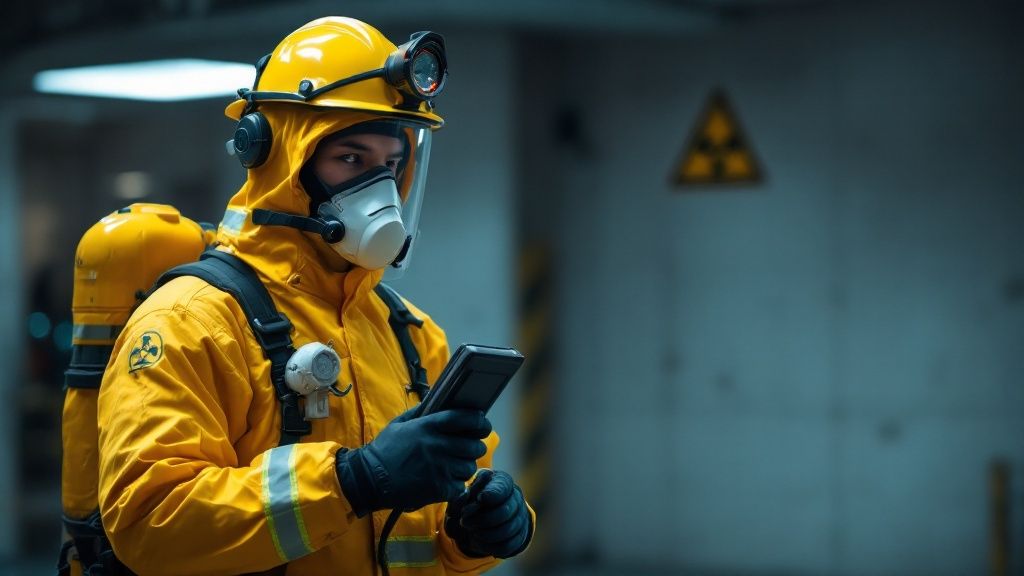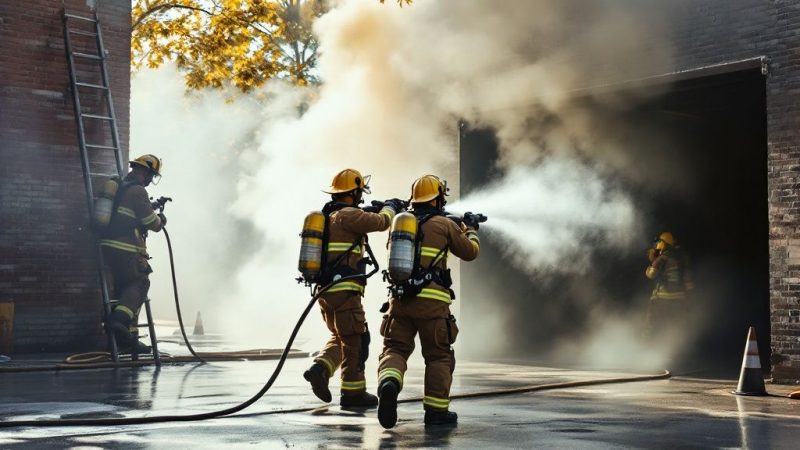Top Fire Fighter Training Ideas to Boost Readiness
In the dynamic world of emergency response, conventional training methods are often just the starting point. To truly forge an elite team, fire departments must constantly seek out innovative fire fighter training ideas that push boundaries, enhance situational awareness, and build muscle memory for high-stakes scenarios. This requires a commitment that goes beyond standard drills and certifications. For instance, ensuring all personnel are properly licensed to operate department vehicles is a foundational step; understanding complex vehicle classifications and specific HGV licence requirements is just as critical as mastering pump operations, as it guarantees the team can even reach the incident safely and legally.
This article moves beyond the basics to deliver a curated list of practical, high-impact training exercises. We will explore seven distinct areas, from live-fire simulations and virtual reality immersions to complex technical rescue operations. Each idea is presented with actionable insights and a strong focus on cost-effectiveness, demonstrating how to achieve maximum training value without straining your department's budget. The goal is to provide a roadmap for developing a more resilient, skilled, and coordinated firefighting force prepared for the unpredictable challenges they face on every call. Get ready to discover how to implement advanced training scenarios that are both effective and economical.
1. Live Fire Training: Mastering the Flames Firsthand
Nothing prepares a firefighter for the intense reality of a blaze quite like confronting one head-on. Live fire training is the gold standard for experiencing the dynamics of a real fire within a controlled, educational environment. It moves beyond theoretical knowledge, immersing crews in the intense heat, smoke, and sensory overload of an actual structural fire.
This method involves using specially designed burn buildings, mobile props, or acquired structures slated for demolition. Under the strict supervision of certified instructors, firefighters practice everything from initial attack and hose line advancement to ventilation and search-and-rescue operations amidst genuine flames. A practical example would be setting up a scenario to attack a simulated basement fire, teaching crews to control the flow path and manage extreme heat from a disadvantaged position. It’s one of the most effective fire fighter training ideas because it allows for direct observation of fire behavior, flashover conditions, and the immediate impact of suppression techniques.
Why It's a Top-Tier Training Method
Live fire exercises are invaluable because they build muscle memory and mental resilience under extreme stress. This hands-on experience solidifies skills in a way that no simulation can replicate. Firefighters learn to read smoke, anticipate fire spread, manage their air supply, and communicate effectively when visibility is zero and adrenaline is high. This raw, firsthand experience is crucial for developing the confidence and competence needed on the fireground.
Actionable Implementation Tips
To maximize the value and safety of live fire training, departments should:
- Follow NFPA 1403: Adhere strictly to the Standard on Live Fire Training Evolutions. This is the bedrock of safety, outlining requirements for instructor-to-student ratios, pre-burn planning, water supply, and emergency medical services.
- Focus on Specific Objectives: Don't just "burn for burning's sake." Design each evolution with clear, measurable goals. One burn might focus on hoseline advancement and fire stream management, while another could center on hydraulic ventilation tactics. A practical example is to challenge crews to advance a charged hoseline up a staircase and into a room, all under live fire conditions, to practice managing kinks and corners under duress.
- Utilize Acquired Structures: Partner with local property owners or municipalities to use buildings scheduled for demolition. This provides a unique, non-repetitive layout for each drill, closely mimicking real-world scenarios.
Key Insight: To save money, consider regional training partnerships. Sharing the expense of a certified training facility, instructor fees, and fuel costs with neighboring departments can make this high-impact training more accessible. This collaborative approach not only reduces the financial burden on a single department but also fosters invaluable inter-agency cooperation.
2. Virtual Reality Fire Simulation
Virtual Reality (VR) is transforming firefighter training by providing immersive, realistic, and risk-free environments to practice complex skills. This technology places firefighters inside computer-generated scenarios, from high-rise fires to hazardous materials incidents, allowing them to experience the sensory pressures of an emergency without any physical danger. For example, a trainee can practice navigating a smoke-filled hospital wing to locate the fire's origin, a scenario that would be impossible to replicate physically.
VR simulation is one of the most innovative fire fighter training ideas because it allows for infinite repetition and immediate feedback. Systems like FLAIM Systems, used by the London Fire Brigade, provide haptic feedback to simulate hose line pressure and radiant heat, creating a deeply immersive experience. Firefighters can practice everything from initial size-up and equipment selection to complex tactical maneuvers, all within a safe and measurable digital space.

Why It's a Top-Tier Training Method
The power of VR lies in its ability to build critical thinking and muscle memory for low-frequency, high-consequence events. Firefighters can face scenarios like a lithium-ion battery fire or a complex industrial accident multiple times, building confidence and refining their response protocols. These platforms track performance metrics, providing instructors with objective data on reaction times, decision-making processes, and procedural adherence. This data-driven approach allows for highly personalized and effective coaching.
Actionable Implementation Tips
To effectively integrate VR simulation into your training program, departments should:
- Combine VR with Physical Drills: Use VR to build cognitive skills and decision-making abilities, then reinforce those lessons with hands-on physical training. For example, practice a search-and-rescue pattern in VR before performing it in a blacked-out training maze.
- Focus on Team-Based Scenarios: Utilize multiplayer modes to train entire crews on communication, command structure, and coordinated tactical operations. A practical example is a scenario where an incident commander directs multiple VR-based teams to attack a fire and conduct a search simultaneously, testing command-level decision-making.
- Document and Review Performance: Leverage the platform's built-in analytics to track individual and team progress over time. Use this data during debriefs to identify strengths and pinpoint specific areas for improvement, creating a continuous feedback loop.
Key Insight: To save money, view VR not as a replacement but as a cost-effective supplement. By using VR for repetitive cognitive training, you can reduce the wear and tear on expensive physical equipment like SCBAs and turnout gear. A single VR system allows for hundreds of training evolutions without consuming fuel, water, or foam, drastically lowering long-term operational training costs.
3. High-Rise Rescue Drills: Conquering the Vertical Challenge
High-rise incidents present a unique and formidable set of challenges, from extreme vertical distances and complex building systems to the sheer physical exertion required. High-rise rescue drills are specialized training evolutions designed to prepare firefighters for these demanding environments. They move beyond standard ground-level tactics, focusing on the specific strategies needed to manage emergencies in multi-story structures.

This training encompasses a wide range of critical skills, including stairwell operations with heavy gear, standpipe connections, rope rescue from upper floors, and elevator emergencies. A practical example involves having crews carry a high-rise hose pack to the 10th floor, connect to the standpipe, and charge the line, simulating the immense physical demand and teamwork required. Drills like this are essential fire fighter training ideas for urban and suburban departments. Real-world examples, like the FDNY’s intensive training at their specialized facility or the Chicago Fire Department's drills in actual skyscrapers, highlight the necessity of this focused preparation.
Why It's a Top-Tier Training Method
The value of high-rise drills lies in building both physical endurance and tactical discipline. The immense physical strain of a full-gear stair climb cannot be simulated; it must be experienced to be understood. These drills prepare crews for the fatigue, air consumption challenges, and communication breakdowns that are common in vertical operations. They force firefighters to master logistical planning, equipment staging, and team coordination in a complex, three-dimensional environment where gravity is a constant adversary.
Actionable Implementation Tips
To effectively integrate high-rise training, departments should:
- Secure Training Locations: Partner with local building managers of office towers, hotels, or large apartment complexes to use their stairwells and floors for non-destructive drills. Many are willing to cooperate in the interest of their own tenants' safety.
- Focus on Incremental Skills: Break down the training. One session might focus solely on the physical conditioning of a stair climb with a hose pack. Another could practice standpipe connections and pressure regulation. A practical example is to use a parking garage to simulate rope rescue techniques from an upper level, allowing for safe repetition of anchoring and lowering systems.
- Simulate Realistic Conditions: Incorporate elements that mimic real emergencies. Use theatrical smoke to obscure vision in stairwells, introduce simulated communication failures, and conduct drills after a strenuous physical warm-up to replicate the effects of fatigue.
Key Insight: To save money, conduct non-destructive "walk-through" drills instead of full-scale simulations whenever possible. Partnering with a building manager to simply walk crews through the HVAC, fire pump, and standpipe rooms provides invaluable pre-incident knowledge at zero cost beyond personnel time. This familiarity can be more critical than a physical drill and builds relationships with property managers.
4. Hazardous Materials (HAZMAT) Response Training
The modern fire service faces threats far beyond traditional fires. Hazardous materials incidents, from overturned tanker trucks to industrial accidents, require a specialized skill set to manage safely and effectively. HAZMAT response training equips firefighters with the critical knowledge to identify, isolate, and mitigate threats from chemical, biological, radiological, and nuclear substances.
This training moves beyond basic fire suppression into the complex world of chemistry and toxicology. It covers everything from recognizing HAZMAT placards and using the Department of Transportation (DOT) Emergency Response Guidebook to executing complex decontamination procedures. A practical example is a tabletop drill where crews are given a scenario of a leaking tanker truck with a specific placard number and must use the ERG to determine the chemical, evacuation distance, and proper PPE. This is one of the most vital fire fighter training ideas because it prepares crews for low-frequency, high-risk events that can have catastrophic consequences if mishandled.

Why It's a Top-Tier Training Method
HAZMAT training is indispensable for protecting first responders and the public from invisible dangers. It instills a methodical, risk-based approach to incident management, emphasizing scene safety and control above all else. Firefighters learn to operate specialized monitoring equipment, select and don appropriate personal protective equipment (PPE), and establish containment zones. This specialized knowledge prevents a bad situation from becoming a multi-casualty disaster, safeguarding both the community and the environment.
Actionable Implementation Tips
To build a robust and cost-effective HAZMAT training program, departments should:
- Master the Emergency Response Guidebook (ERG): Make ERG drills a regular part of company training. Use tabletop scenarios involving different placards and chemical names to build rapid identification and initial action plan skills. This foundational skill costs nothing but time.
- Practice Decontamination Procedures: Regularly set up and run through decon corridors, even without live contaminants. A practical example is timing crews to see how quickly they can establish a full decontamination line from the apparatus. This builds muscle memory for a critical, often chaotic, part of the response.
- Coordinate with Local Industrial Facilities: Partner with local businesses that use or store hazardous materials. They often have on-site experts and may be willing to co-host joint training drills, providing invaluable, site-specific knowledge and experience.
Key Insight: To save money on expensive consumables, use expired materials for training. For example, use old or out-of-date absorbent pads and booms for spill control drills. This allows for hands-on practice without consuming your active response inventory, effectively doubling the value of materials that would otherwise be discarded.
5. Search and Rescue (SAR) Simulation: Finding Life in the Void
The core mission of firefighting often comes down to one critical task: locating and rescuing trapped individuals. Search and Rescue (SAR) simulations are designed to hone the skills necessary to perform this duty under the most challenging conditions imaginable. This training moves beyond simple drills, creating high-fidelity scenarios that replicate the chaos, disorientation, and urgency of a real victim search.
This method uses a combination of blacked-out training mazes, smoke machines, and volunteer "victims" or weighted manikins to simulate realistic environments. For a practical example, a crew can be tasked to find a 175-pound rescue dummy in a zero-visibility, multi-room structure with their search rope, forcing them to practice communication and orientation skills. These exercises are among the most crucial fire fighter training ideas because they directly build the systematic skills and communication protocols that save lives when seconds count.
Why It's a Top-Tier Training Method
SAR simulations are essential for developing muscle memory for systematic search patterns and building confidence in zero-visibility environments. This training forces crews to rely on their tools, senses (other than sight), and each other to methodically clear a structure. It transforms theoretical knowledge of primary and secondary searches into a practiced, instinctual skill set, ensuring that no area is missed and that crew accountability is maintained under extreme duress.
Actionable Implementation Tips
To create effective and safe SAR simulations, departments should:
- Train for Zero Visibility: Don't just dim the lights. Use blackout masks or theatrical smoke to completely remove vision, forcing firefighters to rely on thermal imaging cameras (TICs), tools, and touch to navigate and search.
- Vary the Scenario: Reconfigure the training maze or use different acquired structures for each drill. A practical example is creating a "hoarder" scenario by filling a room with old furniture, boxes, and debris, forcing crews to navigate a complex and unstable environment.
- Practice Victim Packaging and Removal: Finding the victim is only half the battle. Drills must include the entire process of assessing, packaging (using webbing, SKEDs, or backboards), and removing a victim through difficult egress points.
Key Insight: To save money on building complex training mazes, utilize readily available "structures of opportunity." Obtain permission to use vacant warehouses, schools during summer break, or buildings slated for demolition. These real-world layouts offer diverse challenges at no cost and are far more realistic than a permanent training structure.
6. Wildfire Suppression Training: Taming the Unpredictable
As the wildland-urban interface expands, specialized wildfire suppression training is no longer a niche skill but a critical necessity for departments nationwide. This training moves firefighters out of the structural environment and into the complex, dynamic world of natural vegetation fires. It focuses on predicting fire behavior, using specialized tools, and coordinating large-scale, multi-agency responses in difficult terrain.
This discipline involves mastering techniques vastly different from structural firefighting. Crews learn to cut firelines, conduct controlled burns, deploy fire shelters, and operate specialized equipment. A practical example involves teaching crews to create a defensible space around a structure by clearing brush and deploying a progressive hoselay from a wildland engine. This is one of the most essential fire fighter training ideas for any department facing seasonal wildfire risk, as it equips them with the strategies needed to protect communities.
Why It's a Top-Tier Training Method
Wildfire suppression training builds a unique skill set centered on environmental awareness and large-scale strategy. Firefighters learn to read weather patterns, understand how topography influences fire spread, and manage logistical challenges over vast areas. This hands-on training develops physical endurance and mental fortitude, preparing crews for long, grueling deployments in austere conditions where self-sufficiency is paramount. It fosters an understanding of fire as a natural force, which is crucial for effective containment.
Actionable Implementation Tips
To build a robust wildfire training program, departments should:
- Focus on Local Conditions: Tailor training to your region’s specific fuel types, topography, and weather patterns. A practical example is conducting a "sand table" exercise using a map of a high-risk local area to simulate fire spread and plan resource deployment.
- Master the Tools of the Trade: Dedicate significant time to hands-on practice with wildland-specific tools. This includes the proper use and maintenance of Pulaskis, McLeod tools, drip torches, and portable water pumps.
- Practice Shelter Deployment: Make fire shelter deployment a regular, timed, and high-stress drill. The ability to deploy a shelter in under 20 seconds can be the difference between life and death. Run "last resort" scenarios to build this critical muscle memory.
Key Insight: To save money, leverage free or low-cost resources from federal and state agencies. The National Wildfire Coordinating Group (NWCG) offers standardized curriculum and courses online for free. Partnering with your state’s forestry service or the U.S. Forest Service can provide access to expert instructors and resources, significantly reducing the financial burden of developing a program from scratch.
7. Technical Rescue Operations: Excelling Beyond the Blaze
Firefighting extends far beyond extinguishing flames; it often involves rescuing individuals from highly complex and hazardous situations. Technical rescue operations training equips firefighters with the advanced skills needed for low-frequency, high-risk events where standard tactics are insufficient. This specialized discipline covers a wide range of scenarios, from high-angle rope rescues and confined space entries to trench collapses and vehicle extrication.
This training moves personnel from general awareness to operational or technician-level proficiency. It involves hands-on practice with specialized equipment like ropes, harnesses, shoring materials, and hydraulic tools. A practical example is setting up a scenario where a crew must extricate a trapped victim from a vehicle that has rolled onto its side, requiring stabilization struts and a strategic cutting plan. These drills are critical fire fighter training ideas because they prepare teams for emergencies where lives hang in the balance.
Why It's a Top-Tier Training Method
Technical rescue training is essential for building a versatile and capable fire department. These incidents demand a unique blend of critical thinking, physical strength, and procedural discipline. Mastering these skills ensures that crews can safely and effectively operate in environments that would otherwise be inaccessible. This specialized readiness instills confidence and provides a systematic approach to mitigate chaos during multifaceted emergencies, directly improving victim survivability rates.
Actionable Implementation Tips
To develop a robust technical rescue capability, departments should:
- Follow NFPA Standards: Build your program around NFPA 1006 (Standard for Technical Rescue Personnel Professional Qualifications) and NFPA 1670 (Standard on Operations and Training for Technical Search and Rescue Incidents).
- Focus on Foundational Skills: Before tackling complex scenarios, ensure every team member has mastered the basics. A practical example is holding "knot of the week" drills where firefighters must tie critical knots like the figure-eight follow-through or bowline blindfolded. Repetition here is key.
- Use Realistic Props and Scenarios: Practice with actual vehicles for extrication, build training props for confined spaces, and utilize local structures (with permission) for rope rescue drills. The more realistic the training, the better the performance on a real call.
Key Insight: To save money on extrication training, partner with local towing companies and auto salvage yards. They often provide scrap vehicles for free or at a very low cost. This gives crews invaluable, realistic practice on cutting modern vehicles without the high expense of purchasing training props.
Firefighter Training Methods Comparison
| Training Type | Implementation Complexity 🔄 | Resource Requirements ⚡ | Expected Outcomes 📊 | Ideal Use Cases 💡 | Key Advantages ⭐ |
|---|---|---|---|---|---|
| Live Fire Training | High – requires controlled burn setups, safety teams | Very High – real fuels, safety gear, buildings | Realistic fire behavior understanding; team coordination | Fire suppression skills; real fire exposure | Most realistic; confidence building; real conditions |
| Virtual Reality Fire Simulation | Moderate – tech setup, VR hardware/software | Moderate – VR headsets, computers, maintenance | Safe scenario repetition; detailed analytics | Risk-free training; scenario variety | Zero physical risk; cost-effective long-term |
| High-Rise Rescue Drills | Moderate to High – requires tall structures, specialized gear | High – ladders, rope systems, protective equipment | Physical endurance; vertical operations skills | Urban high-rise emergencies | Builds endurance; specializes in vertical rescues |
| HAZMAT Response Training | High – complex certification, multi-agency coordination | High – specialized suits, detection & decontamination equipment | Chemical hazard mitigation; public safety | Chemical, biological, radiological incidents | Critical for safety; federally mandated |
| Search and Rescue (SAR) Simulation | Moderate – props, smoke machines, volunteers | Moderate to High – setups, communication devices | Systematic search skills; victim rescue | Collapse, confined, wilderness rescue | Life-saving skills; stress inoculation |
| Wildfire Suppression Training | High – outdoor, weather dependent operations | High – specialized tools, equipment, multi-agency | Fire behavior prediction; wildfire control | Wildfire and vegetation fires | Specialized for wildland fires; federal pathways |
| Technical Rescue Operations | High – multi-disciplinary, complex scenarios | High – rope gear, extrication tools, monitoring devices | Advanced rescue skills; multi-hazard readiness | Confined space, structural collapse, vehicle extrication | Specialized; career advancement; versatile skills |
Integrating Training and Technology for Peak Readiness
The journey from a proficient firefighter to an elite first responder is paved with consistent, challenging, and innovative training. We've explored a comprehensive range of fire fighter training ideas, from the intense realism of live fire exercises and high-rise rescue drills to the intricate demands of HAZMAT response and technical rescue operations. Each drill, whether conducted in a state-of-the-art virtual reality simulator or a rugged wildland environment, serves a singular purpose: to build muscle memory, sharpen critical thinking, and forge unbreakable team cohesion under pressure.
The core takeaway is that effective training is never static. It evolves, adapting to new challenges and embracing new methodologies. The most successful fire departments are those that move beyond the "check-the-box" mentality and foster a culture of continuous improvement. This means not just practicing the basics but actively seeking out complex, multi-faceted scenarios that push crews beyond their comfort zones. It involves integrating realistic props, simulating equipment failures, and creating dynamic environments that mirror the unpredictability of a real emergency scene.
Turning Ideas into Actionable Plans
Transforming these concepts from a list into a functional training calendar requires deliberate planning and resource management. Here are your next steps:
- Conduct a Skills Gap Analysis: Evaluate your team's current proficiencies against the scenarios outlined in this article. Where are the weakest links? Prioritize drills that address these specific areas, whether it's rope rescue techniques or complex search and rescue patterns.
- Create a Progressive Training Schedule: Don't jump into the most complex drills immediately. Build a curriculum that starts with foundational skills and gradually introduces more variables and stressors. For example, master basic victim drags before attempting a multi-story search and rescue simulation in a smoke-filled structure.
- Leverage Mutual Aid Partnerships: Many advanced training exercises, particularly for HAZMAT or wildfire suppression, require significant resources. By partnering with neighboring departments, you can pool equipment, share instructor expertise, and conduct large-scale drills that would be impossible to execute alone. This collaboration not only strengthens inter-agency communication, a critical component of any major incident response, while distributing the financial burden.
The Lasting Impact of Elite Training
Ultimately, the value of investing in these diverse fire fighter training ideas extends far beyond the training ground. It translates directly to enhanced safety for both the public and your personnel. A well-trained firefighter is more confident, makes better decisions under duress, and operates more efficiently, which can significantly reduce property damage and, most importantly, save lives. This commitment to excellence ensures that when the alarm sounds, your team is not just reacting; they are responding with a level of skill and coordination that defines the modern fire service. It is this dedication that builds community trust and cements your department's reputation as a reliable pillar of public safety.
Ready to streamline your training management and operational logistics? Resgrid, LLC offers a powerful platform to schedule drills, track certifications, and manage personnel, ensuring your team is always prepared. Visit Resgrid, LLC to see how our tools can help you implement these fire fighter training ideas more efficiently and cost-effectively.

